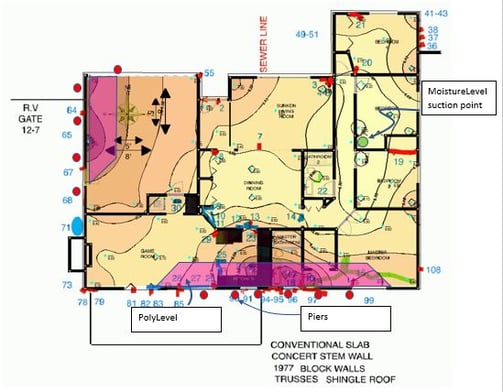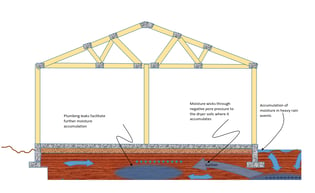It would have been easy and cheap to address this problem if identified clearly and done at the time of the other work.
We had a job that underscores the importance of making sure that we are as a result of all of our hard work … that we are making our customers lives better.
 In a previous blog, I discussed how we have learned over the years from mistakes we have made. In this blog, we are going to take a look at another learning opportunity we had.
In a previous blog, I discussed how we have learned over the years from mistakes we have made. In this blog, we are going to take a look at another learning opportunity we had.
Our interpretation of this profile was that there was both settlement and heave. The high profile in the middle is indicative of a classic center heave problem of an older home. This high center profile is accompanied with damage in the middle areas that indicate that the slab has moved to this position as opposed to originating that way.
In addition, we interpreted the low areas at the rear of the master bath and northwest garage as settlement. The lows were not matched uniformly with lows on most of the perimeter. Also, there were plenty of exterior wall damages indicating footing movement near those low areas.
We feel strongly that we interpreted this correctly. The south perimeter area of the master bedroom and bath had a large crack that ran parallel to the south wall (see green line on graphic to the left) accompanied with a severe slope in that area. The master bath also had a door to the outside.
As an aside note, the homeowner was advised by an “expert foundation repair specialist” that we had identified the foundation type wrongly and that it was really a “monolithic foundation”. This not only had no bearing on the interpretation or repair methods but was flat out wrong. This false interpretation was based on mis-identifying the “pour out slab” (see post https://www.foundationaz.com/blog/rules-of-thumb-part-viii-interpreting-signs-of-stress) at the rear door (with out a joint between the slab and stem wall). When we dug down to attach our piles to the footings, we indeed did verify our original diagnoses.
After the piering and PolyLevel injections, the homeowner who refused to be present as required by our contract during the lift was unhappy about the slope of the floor and felt that we should have lifted more. Perhaps. But not without risking damaging the masonry at the rear of the house.
Ultimately much of the slope of the floor was from the heave of the center areas…. Which was being controlled by the MoistureLevel® system that we installed.
Where we could have done a better job was identifying the slope of the floor as a main concern and specified a floor leveler to address that concern. Here we did everything technically correct. We identified the mechanisms of failure correctly, we specified products correctly to remedy those problems and installed them correctly. However, we failed to understand the customer’s main goal and address it proactively.
It would have been easy and cheap to address this problem if identified clearly and done at the time of the other work. The customer in this case spent over $20,000 with us and yet we failed to fix the item of his most important concern. As a result of this and similar cases, we have implemented a series of policies that clearly identify the customer’s main goals and that those goals are communicated clearly to all of our team members so that they can review those with the home owners to insure that that their main goals and concerns are being addressed.






